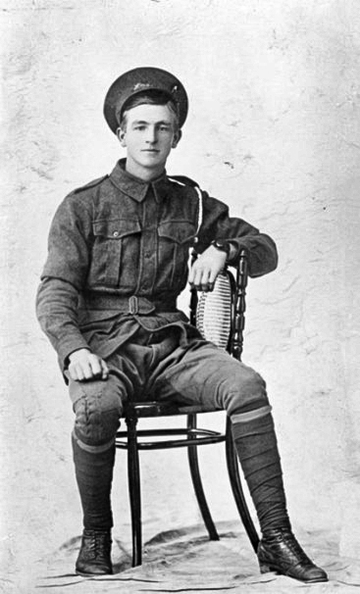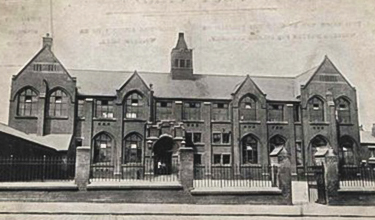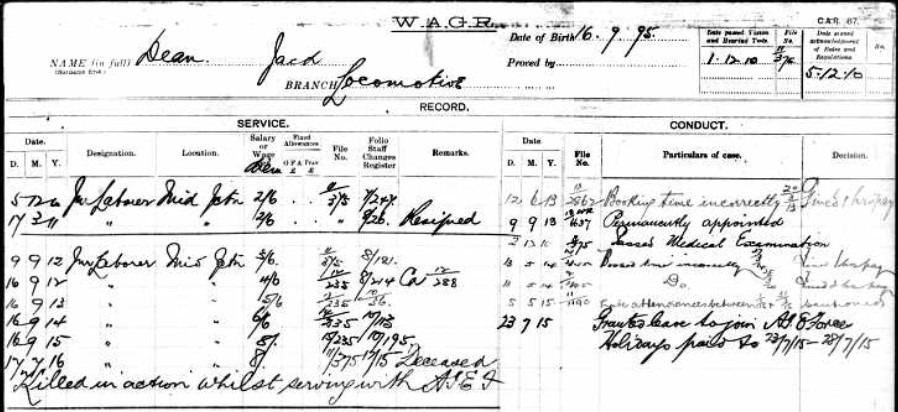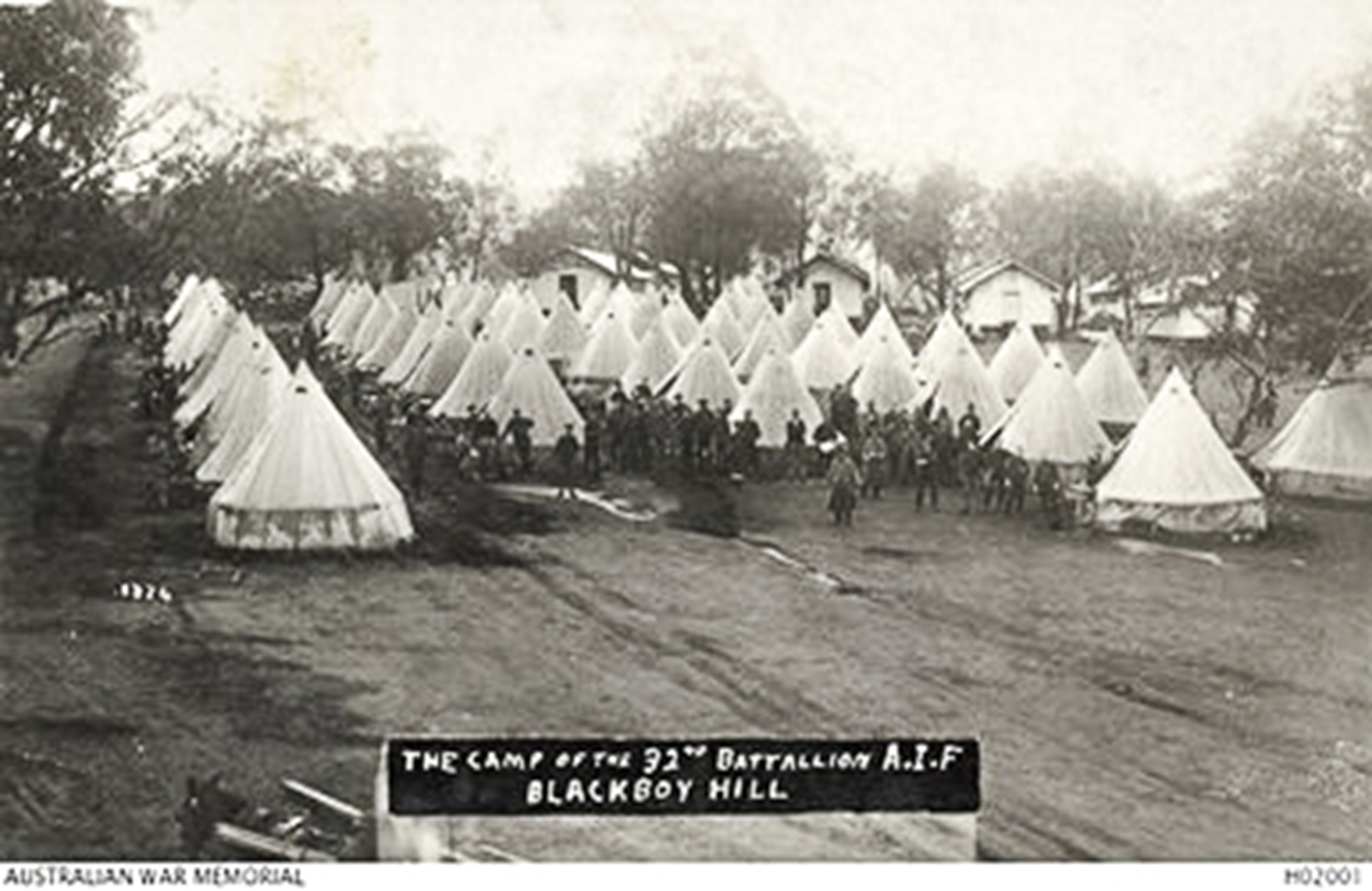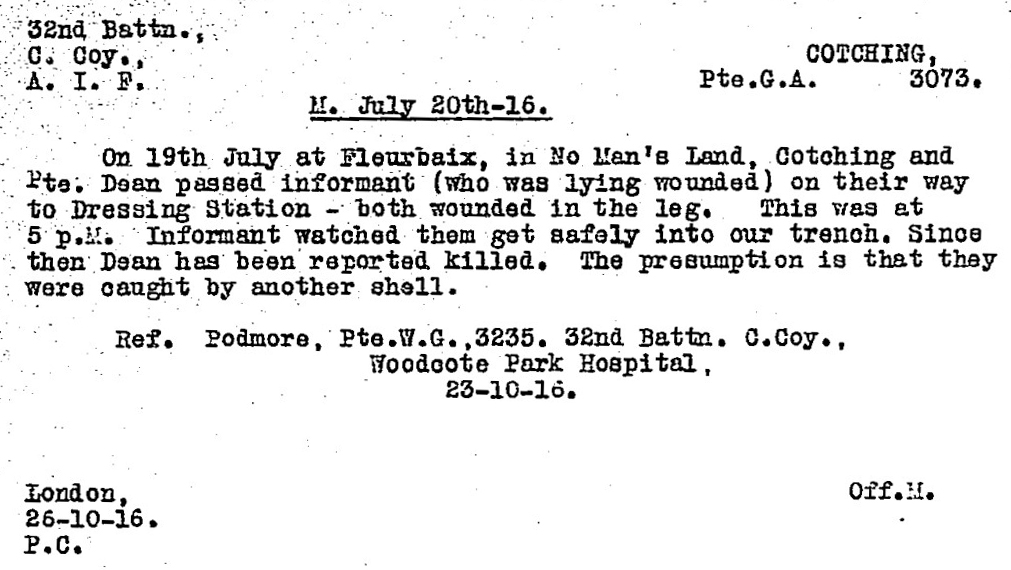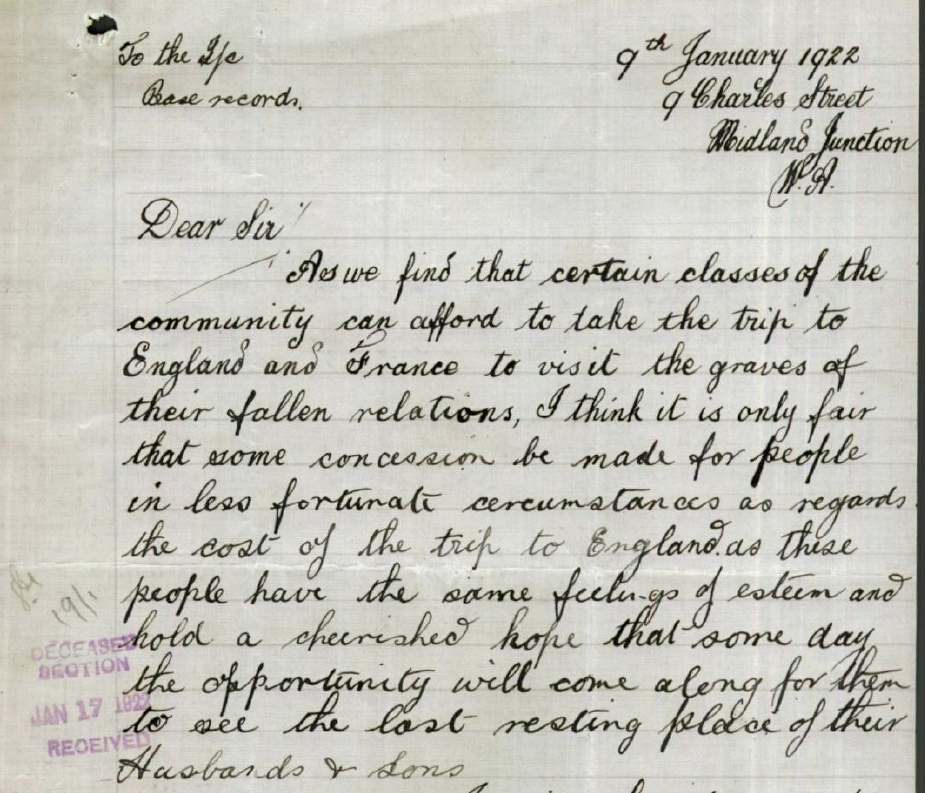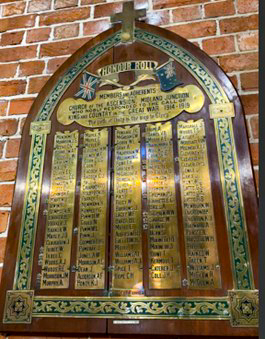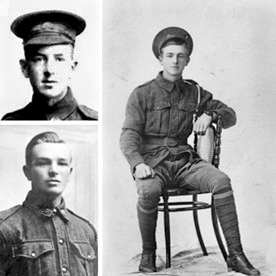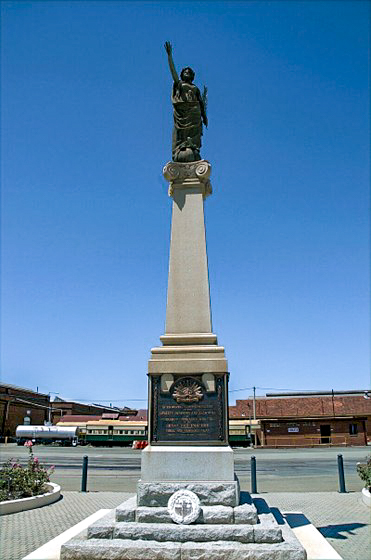Jack DEAN
Eyes blue, Hair light brown, Complexion fair
Jack Dean – A Young Railwayman Lost at Fromelles
Can you help find Jack?
Jack Dean’s body was never found after the Battle of Fromelles and there are no records of his burial. A mass grave was found in 2008 at Fromelles, a grave the Germans dug for 250 Australian soldiers they recovered after the battle. As of 2024, 180 of these soldiers have been able to be identified via DNA testing.
Jack may be among these remaining 70 unidentified men. There is still a chance to identify him — but we need help. We welcome all branches of his family to come forward to donate DNA to help with his identification, especially those with roots in Bolton, England.
See the DNA box at the end of the story for what we do know about his family. If you know anything of contacts for Jack, please contact the Fromelles Association.
Early Life
Jack Dean was born on 16 September 1895 in Bolton, Lancashire, England, the busy cotton-mill town where his parents, William Henry and Elizabeth Adeline Dean (née Entwistle), were raising a growing family. He was baptised at All Souls Church, Bolton a few weeks later and spent his childhood in a typical Lancashire terraced street, surrounded by the sounds of industry. William and Elizabeth had four children:
- Charles Entwistle (1893–1917) served with the 28th Battalion and died of wounds in Belgium
- Jack (1895-1916) KIA and missing at Fromelles
- Harry Stanley known as Stanley (1897–1981) served with the 44th Battalion, and was eventually returned home for family reasons. He later served in WWII.
- Elizabeth (Bess) Adelina (c.1901–1997) married Robert Horace Holloway in 1922 and lived into her nineties
In the 1901 Census, six-year-old Jack was living with his parents and siblings in nearby Farnworth, a town just outside Bolton. He attended the Chalfont Street Board School in Bolton, a school that served working-class children of mill workers, clerks, and tradesmen.
Their lifes changed dramatically in 1910, when Jack and his elder brother Charlie (then 17) boarded a ship bound for Australia. The two young brothers were just teenagers — Jack only 15 — but they set out ahead of their family to start a new life in Western Australia. They must have already been working in England and had some idea of employment opportunities in Australia, with assisted passages:
“The High Commissions have lost no time in inaugurating his scheme for adversing Australia through the length and breadth of Great Britain’ Next week a series of Commonwealth advertisements will appear in twenty leading London newspapers and 264 provincial papers.”
Charlie and Jack arrived at Fremantle in October that year, while their parents and younger siblings remained behind in Bolton before following them to Australia. By the time the rest of the family had settled in Midland Junction, WA, outside of Perth, the older boys were already established. Jack found steady work at the Midland Railway Workshops, where he was employed in the Locomotive Branch as a striker in the blacksmith’s shop. He was a tall young man and must have been extremely fit.
The first railway workshops in Western Australia were located at Fremantle and shifted to Midland in 1904. The Midland Railway Workshops were involved with all WA Government Railway rolling stock and engine construction and maintenance.
Source: https://en.wikipedia.org/wiki/Midland_Railway_Workshops
Off to War
Jack had been working at the Midland Railway Workshops for nearly two years when war broke out. Like many young men from the workshops, he felt the pull to enlist. On 26 July 1915, just shy of his 20th birthday, Jack presented himself at Perth to join the AIF. Being under 21, he needed his parents’ permission and both his father and his mother signed the papers. Charlie enlisted six months later, on February 29, 1916, and Stanley on 12 July, 1916.
Jack was posted to C Company of the 32nd Battalion. The 32nd Battalion was formed at Mitcham, South Australia on 9 August 1915. A and B Companies were made up of recruits from South Australia and C and D Companies came from Western Australia. The men from WA did their initial military training at the Blackboy Hill Camp, outside of Perth.
Jack and his mates were sent to Adelaide at the end of September and the whole battalion was assembled at the Cheltenham Racecourse Camp. Training continued until the battalion departed for Egypt on 18 November 1915, with the unit being split between two troop ships HMAT A2 Geelong (Jack’s) and HMAT A13 Katuna.
As reported in The Adelaide Register:
“The 32nd Battalion went away with the determination to uphold the newborn prestige of Australian troops, and they were accorded a farewell which reflected the assurance of South Australians that that resolve would be realized.”
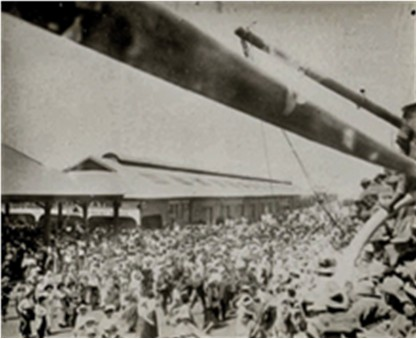
Jack arrived in Suez on 14 December 1915 and was moved to El Ferdan just before Christmas. A month later they marched to Ismailia and then to the major camp at Tel-el-Kebir where they stayed for February and most of March. Tel-el-Kebir was about 110 km northeast of Cairo and the 40,000 men in the camp were comprised of Gallipoli veterans and the thousands of reinforcements arriving regularly from Australia.
His next stop was at Duntroon Plateau and then at Ferry Post until the end of May where the 32nd trained and guarded the Suez Canal. Jack was promoted to Lance Corporal on 16 March 1916. Their last posting in Egypt was a few weeks at Moascar.
One soldier’s diary complained of being “sick up to the neck of heat and flies”, of the scarcity of water during their long marches through the sand and he described some of the food as “dog biscuits and bully beef”. He did go on to mention good times as well with swims, mail from home, visiting the local sights and the like.
Source: AWM C2081789 Diary of Theodor Milton PFLAUM 1915-16, page 29, page 12
During their time in Egypt the 32nd had the honour of being inspected by H.R.H. Prince of Wales.
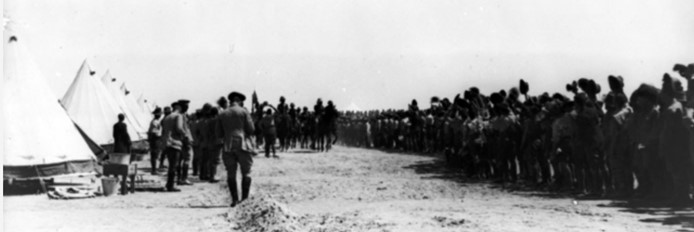
After spending six months in Egypt, the call to support the British Expeditionary Force on the Western Front came in mid-June. The 32nd left from Alexandria on the ship Transylvania on 17 June 1916, arriving at Marseilles, France on 23 June 1916 and they then immediately entrained for a three-day train trip to Steenbecque. Their route took them to a station just out of Paris, within sight of the Eiffel Tower, through Boulogne and Calais, with a view of the English Channel, before disembarking and marching to their camp at Morbecque, about 30 kilometres from Fleurbaix.
Theodor Pflaum (No. 327) and Wesley Choat (No. 68) wrote about the trip:
“The people flocked out all along the line and cheered us as though we had the Kaiser as prisoner on board!!” – Theodore Pflaum
“The change of scenery in La Belle France was like healing ointment to our sunbaked faces and dust filled eyes. It seemed a veritable paradise, and it was hard to realise that in this land of seeming peace and picturesque beauty, one of the most fearful wars of all time was raging in the ruthless and devastating manner of "Hun" frightfulness”. – Wesley Choat
They were headed to the area of Fleurbaix in northern France which was known as the ‘Nursery Sector’ – a supposedly relatively quiet area where inexperienced Allied troops could learn the harsh realities of Western Front trench warfare against the Germans. But the quiet times did not last long. Training continued with a focus on bayonets and the use of gas masks, assuredly with a greater emphasis, given their position near the front.
The 32nd moved to the Front on 14 July and Jack was into the trenches for the first time on 16 July, only three weeks after arriving in France.
The Battle of Fromelles
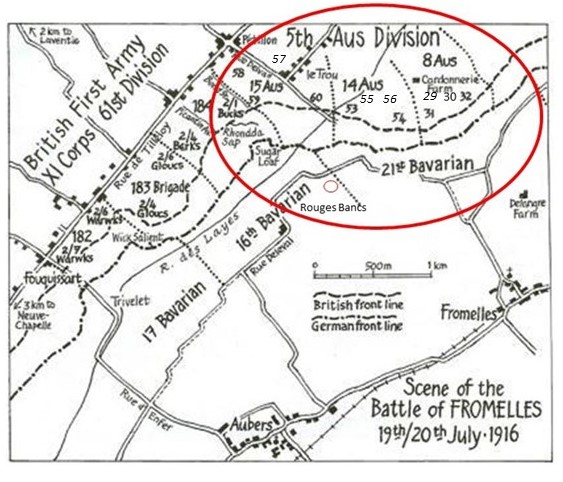
On the 17th they were reconnoitering the trenches and cutting passages through the barbed wire, preparing for an attack, but it was delayed due to the weather. D Company’s Lieutenant Sam Mills’ letters home were optimistic for the coming battle:
“We are not doing much work now, just enough to keep us fit—mostly route marching and helmet drill. We have our gas helmets and steel helmets, so we are prepared for anything. They are both very good, so a man is pretty safe.”
The overall plan was to use brigades from the Australian Fifth Division to conduct a diversionary assault on the German trenches at Fromelles. The 32nd Battalion’s position was on the extreme left flank, with only 100 metres of No Man’s Land to get the German trenches. As they advanced, they were to link up with the 31st Battalion on their right. However, their position made the job more difficult, as not only did they have to protect themselves while advancing, but they also had to block off the Germans on their left, to stop them from coming around behind them.
On the morning of the 18th, A Company and C Company went into the trenches to relieve B and D Companies, who rejoined the next day.
Private Frederick Stolz (No. 17) recalled the calm before the storm:
“The fellows were wonderfully cool and not during the whole time did I see anyone get excited or do anything silly, and such a lot were only young boys of between 18 to 20.”
The Zero Hour for advancing from their front-line trenches was to be 5.45 PM, but the Germans knew this attack was coming and were well-prepared. They opened a massive artillery bombardment on the Australians at 5.15 PM, causing chaos and many casualties. The charge over the parapet began at 5.53 PM. C Company and A Company were to be the first and second waves to go, B & D were the third and fourth.
They were successful in the initial assaults and by 6.30 PM were in control of the German’s 1st line system (map Trench B), which was described as “practically a ditch with from 1 to 2 feet of mud and slush at the bottom”.
Source: AWM4 23/49/12, 32nd Battalion War Diaries, July 1916, page 11
Unfortunately, with the success of their attack, ‘friendly’ artillery fire caused a large number of casualties because the artillery observers were unable to confirm the position of the Australian gains. They were able to take out a German machine gun in their early advances, but were being “seriously enfiladed” from their left flank.
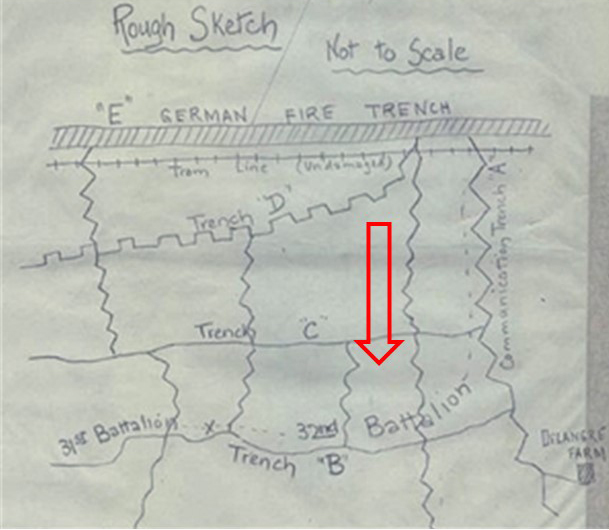
By 8.30 PM their left flank had come under heavy bombardment with high explosives and shrapnel. Return bombardment support was provided and the 32nd were told that “the trenches were to be held at all costs”.
Source: AWM4 23/49/12, 32nd Battalion War Diaries, July 1916, page 12
Fighting continued through the night. The Australians made a further charge at the main German line beyond Trench B, but they were low on grenades, there was machine gun fire from behind them from the emplacement at Delangre Farm and they were so far advanced that they were getting shelled by both sides. In the early morning of the 20th, the Germans began a counterattack from the Australian’s left flank, bombing and advancing into Trench A (map).
Given the Australian advances that had been made earlier, the rear Trench E had been left almost empty, which then enabled the Germans to regain that trench and envelop the men of the 32nd. At 5.30 AM the Germans attacked from both flanks in force and with bombing parties. Having only a few grenades left, the only resistance they could offer was with rifles:
“The enemy swarmed in and the retirement across No Mans’ Land resembled shambles, the enemy artillery and machine guns doing deadly damage.”
What was left of the 32nd had finally withdrawn by 7.30 AM on the 20th. The initial roll call count was devastating – 71 killed, 375 wounded and 219 missing, including Jack. To get some perspective of the battle, when Charles Bean, Australia’s official war historian, attended the battlefield two and half years later, he observed a large quantity of bones, torn uniforms and Australian kit still on the battlefield.
The final impact was that 228 soldiers of the 32nd Battalion were killed or died from wounds sustained at the battle and, of this, 166 were unidentified. Lieutenant Sam Mills survived the battle. In his letters home, he recalls the bravery of the men:
“They came over the parapet like racehorses……… However, a man could ask nothing better, if he had to go, than to go in a charge like that, and they certainly did their job like heroes."
After the Battle
The only witness statement about what happened to Jack came via one of his mates from Midlands.
Based on this statement, Jack would have been among the many casualties in heavy pre-attack shelling from the Germans. Whether he ever made it to the Dressing Station with the wounds to his leg or whether he was killed by another shell as in the Red Cross report is not known. George Cotching was also killed, but his body was recovered and he is buried at the Ration Farm Cemetery. Jack’s body was never recovered.
The Camp Chronicle of Midland Junction was among the first to carry the news:
“Lance Corpl. Jack Dean, killed in action in France on the 17th July. The deceased, who left Western Australia just about twelve months ago, would have celebrated his 21st birthday next month. He was employed in the Loco. Workshops, and was a son of Mr. and Mrs. W. H. Dean of Midland Junction, whose family has done its bit and a bit over. His brother Charlie, formerly secretary of the Midland Junction Rifle Club, is now in France, and a younger brother, Stanley, only just eighteen, is in camp at Claremont.”
Jack was formally declared as having been killed in action on 19 July 1916 by a 21 July report. The loss was devastating to his family. Jack was only twenty, with a bright future in the railway workshops before enlisting. His family kept his memory alive year after year in the press. On the first anniversary of his death in 1917, the West Australian published their sorrow:
“He little thought his time so short In this world to remain.
He thought when he left his home He would return again.
As he waved his last good-bye, We remember the day when parted,
We sigh when we think of the past
But if you must leave us, Jack, Your name will be dear to the last.”`
When Charlie was killed in December 1917, the grief deepened. In 1918 the family placed a joint notice for their two fallen sons:
”No one knows how much we miss them,
More and more as these days go,
How our hearts still break in sorrow,
No one cares and no one knows.
Other relatives and friends added their voices. An uncle and aunt remembered Jack with the words:
”There is a link death cannot sever, Love and remembrance last for ever.”
Even family friends like Nurse Hansen contributed notices, showing how far Jack’s loss was felt in the close-knit Midland community. In 1921, five years after Fromelles, the Swan Express once more carried the Dean family’s message:
“No one knows how much we miss them.”
His siblings Bess and Stanley often added their names to the family tributes, making sure their brothers were never forgotten. Elizabeth Dean, the mother who had given two sons to the war, carried her grief for decades. In January 1922, she wrote to Base Records in Melbourne asking for assistance to visit the graves of “our two sons.” It was a simple, dignified plea from a mother who had lost more than most.
However, the journey never came. Jack has no known grave; his name is carved on the memorial wall at VC Corner, Fromelles. Charlie rests at Westhof Farm Cemetery in Belgium. Together, their names are inscribed on the Midland memorials and the Australian War Memorial in Canberra.
Jack was awarded the 1914-15 Star Medal, the British War Medal, the Victory Medal, a Memorial Plaque and a Memorial Scroll.
Brothers at War
William and Elizabeth’s eldest son, Sergeant Charles Entwistle Dean (4097, 28th Battalion) died of wounds from a bombing raid near Neuve Église, Belgium on 12 December 1917. He is buried at Westhof Farm Cemetery, II. D. 5., Belgium.
Their third son Stanley served with the 44th Battalion, but after a passionate plea by Elizabeth, he was discharged in 1918.
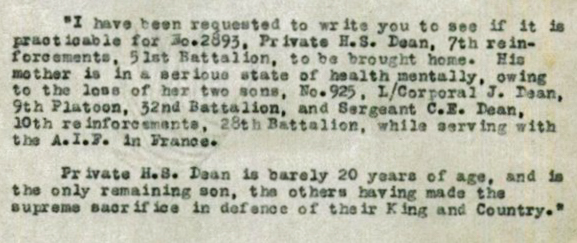
The Dean family’s sacrifice did not end with their sons in the First World War:
- Private John Dean (5842, 28th Battalion), Jack’s uncle, served in France but was invalided home in 1917.
- Private Edmund Dean (2562, 44th Battalion), John’s son and Jack’s cousin, enlisted at 19 and served until the end of the war, returning home in 1919.
- Edmund’s son carried the Dean name back into uniform in WWII - Private John Buckland Dean (NX37699, 2/30th Battalion), born in Perth in 1919, was captured during the Malayan campaign. He died of illness as a prisoner of war in Thailand on 27 November 1943, aged 23. His name is recorded on the Australian War Memorial Roll of Honour and the Ballarat Ex-Prisoners of War Memorial.
Their names, scattered across memorials from Midland, WA to Villers-Bretonneux to Ballarat, VIC remain bound together by their sacrifices.
Finding Jack
Jack’s remains were not recovered, he has no known grave. After the battle, the Germans recovered 250 Australian soldiers and placed them in a burial pit at Pheasant Wood. This grave was discovered in 2008 and since then efforts have been underway to identify these soldiers by DNA testing from family members. As of 2024, 180 of the soldiers have been identified, including 41 of the 166 unidentified soldiers from the 32nd Battalion.
We welcome all branches of Jack’s family to come forward to donate DNA to help with his identification, especially those with roots in Bolton, England. If you know anything of family contacts, please contact the Fromelles Association. We hope that one day Jack will be named and honoured with a known grave.
Please visit Fromelles.info to follow the ongoing identification project and Jack’s story.
DNA samples are being sought for family connections to
| Soldier | Jack Dean (1895–1916) |
| Parents | William Henry Dean (1865–1955, Pendleton, Lancashire, England – Swan, WA) and Elizabeth Adeline Entwistle (1870–1956, Bolton, Lancashire, England – Swan, WA) |
| Siblings | Charles Entwistle Dean (1893–1917) | ||
| Harry Stanley Dean (1897–1981) m. Lillian Emily Price (1897–1979) | |||
| Elizabeth Adelina Dean (1901–1997) m. Robert Horace Holloway (1899–1964) |
| Grandparents | |||
| Paternal | William Henry Dean (1840–1891), Hale Barns, Cheshire – Bolton, Lancashire) & Elizabeth Bradley (1838–1895), Manchester, Lancashire – Bolton, Lancashire) | ||
| Maternal | Luke Entwistle (1844–1897), Bolton, Lancashire) & Sarah Ann Porter (1847–1922), Trowbridge, Wiltshire – Bolton, Lancashire) |
Seeking DNA Donors

Contacts
(Contact: carla@fromelles.info or geoffrey@fromelles.info).
(Contact: army.uwc@defence.gov.au or phone 1800 019 090).
Donations
If you are able, please contribute to the upkeep of this resource.
(Contact: bill@fromelles.info ).
